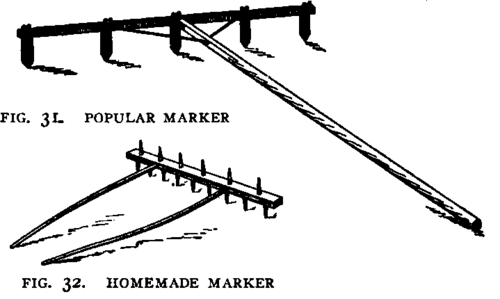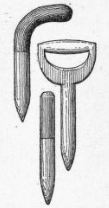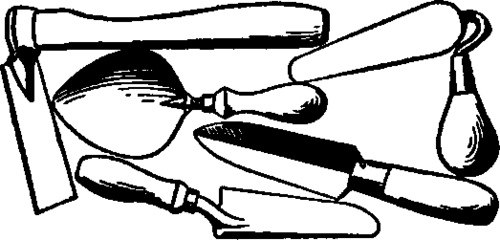205. Markers And Marking
Description
This section is from the book "Vegetable Gardening", by Ralph L. Watts. Also available from Amazon: Vegetable Gardening.
205. Markers And Marking
Straight rows and spaces of uniform width are necessary in the successful management of a market garden. They not only look better, but they also allow more rapid and thorough cultivation with less annoyance to the operator. An 80-acre market garden in Philadelphia county, Pa., is apparently faultless in this particular. In several visits to the farm not a crooked row was apparent to the eye. The owner knows the width of the farm in inches, and even half-inch spaces are taken into account in making the rows. That is, with many crops the distance from center to center of rows is 12 l/2 inches rather than 12 or 13. This example is given to show how very particular the owner is as a garden mechanic. Although often 20 to 30 men are working on the farm, every row for every crop is marked by the owner. The seed drills are then guided over the shallow marks, or the plants are set in them. All the small crops are cultivated with hand wheel hoes and inter-cropping is practiced extensively. The second crop is often well started before the first is harvested. At such times the rows are only 6 1/2 inches from center to center. The reader can readily see how difficult, if not impossible, it would be to use a wheel hoe if the spaces between the rows were not uniform in width. The marker used on this farm is shown in Figure 31. It may be purchased of seed-supply houses. The teeth are easily adjusted, and the scale on the bar to which they are attached makes it possible to space the rows as may be desired. It marks five rows at a time. If the following plan is carried out in the use of this marker, the rows will be perfectly straight.

If the rows are to be 1 foot apart, adjust the teeth to this distance, and stretch a line along one side of the plat to be planted. If the land slopes, the rows should always run with the hill and marking should begin at the upper side of the plat. Take the marker, and with a side tooth barely touching the tightly stretched line, walk backward marking five rows. Have a 9-foot pole at each end of the line. Measure off 9 feet from the first stakes, stretch the line and mark five more rows with the outside tooth touching the line. Repeat these operations until the entire plat is marked.
The homemade device shown in Figure 32 may be substituted, but it is a great advantage to have an adjustable marker with a scale graduated in inches and half inches.

Fig. 33. DIFFERENT FORMS OF DIBBERS.

Fig. 34. DIFFERENT FORMS OF TROWELS.
Roller rope markers are sometimes employed by gardeners, and there are various forms of field markers. In rough, hilly or stony ground nothing is superior to a single shovel plow, provided it is operated by a competent man. The making of straight rows without a line, especially on uneven ground, requires considerable skill.
Continue to:
Tags
plants, crops, gardening, cultivated, harvesting, food ,greenhouses, fertiliser, vegitables
